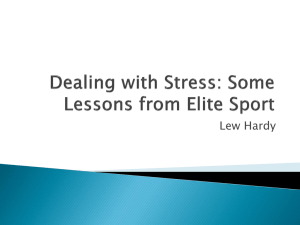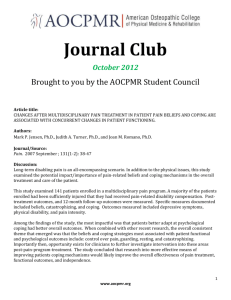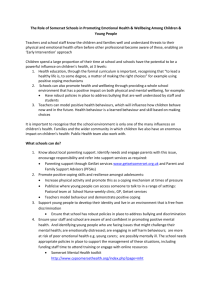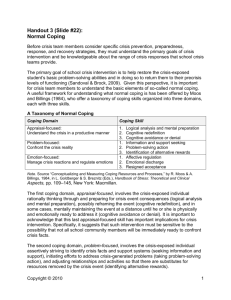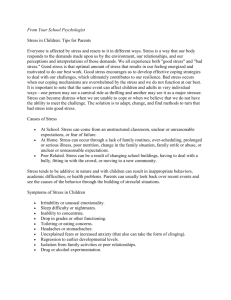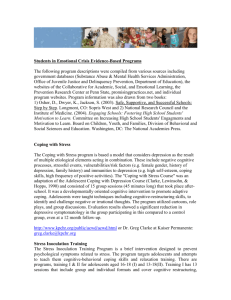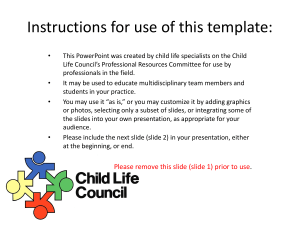Zero-Order Correlations Between Fear, Negative Life Events (NLE)
advertisement
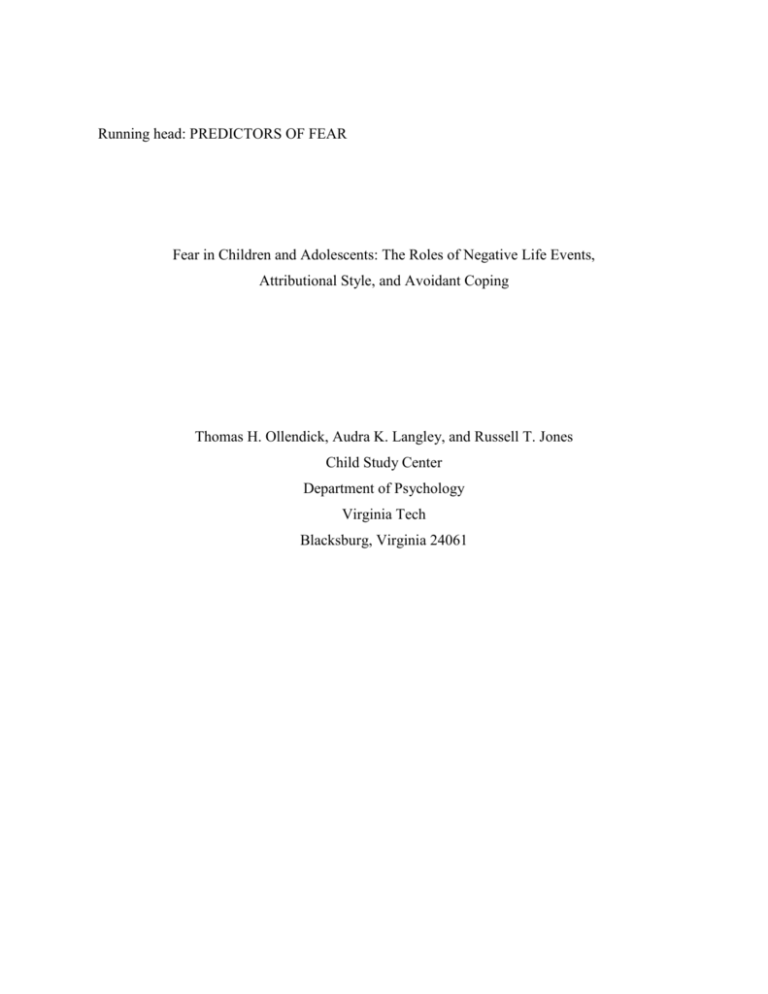
Running head: PREDICTORS OF FEAR Fear in Children and Adolescents: The Roles of Negative Life Events, Attributional Style, and Avoidant Coping Thomas H. Ollendick, Audra K. Langley, and Russell T. Jones Child Study Center Department of Psychology Virginia Tech Blacksburg, Virginia 24061 It is generally accepted that childhood fears are relatively common and that the nature of these fears change systematically across development (cf. Bauer, 1976, King, Hamilton, & Ollendick, 1988; Marks, 1987). For example, young infants are unaffected by events that will frighten them at a later time, whereas older children are no longer affected by events such as separation or strangers that once resulted in major distress for them. Although the exact mechanisms underlying these changes are not fully understood, it is probable that they are in part related to the growing child’s cognitive capacity for recognizing and understanding potential dangers inherent in such situations. As noted early on by Jones and Jones (1928), many common childhood fears emerge because the child is increasingly able to perceive danger in the situation, but has not advanced to the point of fully understanding the situation, nor is able to exercise control over it. In this respect, fears can be said to be adaptive and to possess survival value. They may constitute a protective response to a situation that is neither fully understood nor controllable (Ollendick, Hagopian, & King, 1997). The exact etiology of childhood fears is poorly understood at this time, however. Associative learning theorists suggest that significant learning or conditioning events in the child’s environment explain the onset of specific fears. Rachman (1977), for example, proposed three distinct – though frequently overlapping – pathways to the acquisition of fears: direct conditioning (e.g., the child is exposed to a traumatic event such as a hurricane or a residential fire), modeling (e.g., the child observes fearful behavior in a sibling or parent), and instruction/information (e.g., the child reads a story or hears a news report about hurricanes or residential fires). Studies examining the onset of childhood fears have generally found considerable support for Rachman’s theory (cf, Doogan & Thomas, 1992, King, Clowes-Hollins, 2 & Ollendick, 1997; Ollendick & King, 1991). In these studies, a majority of children (and their parents) report direct and indirect conditioning events precede fear acquisition. Still, not all children and parents report such events. In fact, a sizeable minority (close to one-third) report non-conditioning events. Such findings support the non-associative Darwinian theory of fear acquisition put forth most forcefully by Menzies and Clark (1993). This theory affords much less significance to environmental events such as traumatic events (whether experienced directly or indirectly); rather, it asserts that “most members of the species will show fear to a set of evolutionary-relevant stimuli on their first encounter” (Menzies & Clark, 1993, p. 500). That is, according to this theory, fear to certain stimuli is pre-programmed and of direct evolutionary significance. Moreover, it is further proposed that this initial fearful response will typically diminish across time due to repeated, non-traumatic exposure to the feared object or situation (i.e., habituation). However, “poor” habituators and those who do not experience safe exposure will remain fearful from their first encounter with the feared stimuli. Ultimately, it is probable that a full explanation of fear onset requires recognition of both biological and environmental factors (Ollendick et al., 1997). In addition to specific associative and nonassociative accounts of fear acquisition, Ollendick (1979), Beck (1986), Barlow (1988), and King et al. (1988) have proposed that stress and, more generally, negative life events set the stage for the development and onset of a variety of fears and anxieties. That is, repeated stressful experiences associated with diverse negative life events serve to make the individual more susceptible and to produce a “vulnerability set” for the development of fear when subsequent conditioning events occur. Thus, negative life events might be viewed as a risk factor for the development of heightened levels of fear, much as they are for the development of depression (Seligman, 1975). 3 As in the depression literature (see Gladstone & Kaslow, 1995, and Joiner & Wagner, 1995, for recent reviews), the manner in which the individual explains the causes of negative (and positive) life events is critical in determining whether the events produce negative or positive outcomes. Not unlike their depressed counterparts, fearful and anxious individuals (particularly adults) also report negative attributional styles for life events; that is, they report internal, stable, and global attributions for negative events but external, unstable, and specific attributions for positive events (see Bell-Dolan & Wessler, 1994, for a review). In this regard, negative attributional style cannot be said to be specific to depression; rather, this cognitive style appears to characterize fearful and anxious adults as well. Whether, fearful children report similar attributional styles is currently unknown (Bell-Dolan & Wessler, 1994). Thus, in determining the link between negative life events and heightened levels of fear, it may be important to determine how children explain the cause of such events. Consistent with the adult literature, it would be hypothesized that a negative attributional style would be associated with heightened levels of fear. In addition to attributional style, coping strategies might also be associated with increased levels of fear or, at the least, persistence of fears once they are acquired. In particular, an avoidance coping style may be related most clearly to levels of fear. Avoidance, of course, is the hallmark of fears and phobias as articulated in major diagnostic classification systems (American Psychiatric Association, 1994; World Health Organization, 1992). In the DSM-IV, for example, a phobia is defined as marked or persistent fear that is unreasonable or excessive, cued by the presence or anticipation of a specific object or situation, and avoided or else endured with intense fear or anxiety. Thus, individuals using avoidant coping styles in response to negative life events might more likely develop fears associated with those events. 4 The primary purpose of the present study was to explore the relations among negative life events, attributional style, avoidant coping, and levels of fear in children who experienced a residential fire. Residential fires, in combination with other negative life events, appear to lead to heightened levels of post-traumatic stress symptoms in many children (Jones & Ollendick, in press). Here, we explore its relations to fear. Inasmuch as these relations have not been explored systematically in earlier research with children, we adopted a generic prediction model in which we hypothesized that negative life events, negative attributional style, and avoidant coping would all be related independently to levels of fear. We did not explore mediational or moderational models of fear inasmuch as an examination of such relations would be premature at this time. Method Participants Participants were 46 children and adolescents recruited for a larger grant assessing the effects of residential fire on children and their families in the southeastern United States (see Jones & Ollendick, in press). Families were paid $75 for their participation. The sample was 56.5% female, with a mean age of 11 years 10 months (range 8 years to 16 years). Additionally, the sample consisted primarily of Caucasians (52.2%) and African Americans (43.5%), with Hispanic (2.2%) and Biracial youth (2.2%) represented in smaller proportions. In terms of family structure, 45% of the children lived in single parent families (mother), 25% in divorced but re-married families, and 30% in two-parent families. Given these family structures, maternal education level was used as an index of socio-economic status (SES). On the 7-point Hollingshead scale, the mean was 4.6, indicating that the average family fell near the median (high school graduates). When categorized as high or low, 41.3% of the sample reported low 5 parental education levels (less than 7th grade to high school graduates), and 58.7% reported high levels (some college to graduate degree). Procedures The measures were administered as part of a larger interview conducted in the participants’ homes, neighborhood churches, libraries, or Red Cross offices by advanced graduate clinicians. Informed consent was obtained by parents of participating youth. Moreover, each child and adolescent signed an informed assent form prior to initiation of the interview. Each of the measures was self-administered following instructions from and continued supervision by the graduate clinician. The entire interview took approximately 3 hours to complete. Measures Demographic Information: Demographic information was obtained via parent-report (mother-report, with few exceptions) of child’s age, ethnicity, gender, and parental education level. Information regarding parental education was coded on a scale of 1-7 based on the Educational Factor classification of Hollingshead’s (1975) Four Factor Index of Social Status where 1= less than 7th grade, 2= junior high school (9th grade), 3= partial high school (10th or 11th grade), 4= high school graduate, 5= partial college (at least one year) or specialized training, 6= college or university graduation, and 7= graduate degree. Negative Life Events: The Life Events Checklist (LEC; Johnson & McCutcheon, 1980), a 46 item child and adolescent self-report measure, was utilized to assess the number and perceived impact of stressful life events which occurred in the participant’s life in the past year. Each event is classified as “bad” or “good” and then its impact is rated on a scale from 0-3, 6 where 0= no effect and 3= great effect. The LEC yields a positive life events and negative life events score. Acceptable validity (Johnson & McCutcheon, 1980) and reliability for negative, positive, and total life events on the LEC have been reported (Brand & Johnson, 1982). Representative items include “Moving to a new home”, “Mother or father lost job”, and “Increased absence of parents from the home”. Attributional Style: KASTAN Children’s Attributional Style Questionnaire-Revised (KASTAN-R-CASQ; Kaslow, Tanenbaum, & Seligman, 1978) was employed to assess attributional style for children and adolescents in the current sample. The CASQ is a 48-item forced choice scale measuring causal attributions to an equal number of positive and negative hypothetical situations. The scale yields positive and negative composite scores as well as a total difference score (positive- negative composites). For purposes of the current analyses, difference scores were used. Internal consistency reliabilities for negative composite, positive composite, and difference score were estimated at = .58, .60, and .56, respectively. Although moderate, these reliability estimates are consistent with those reported for this measure in previous studies (’s ranging from .42-.67; see Gladstone & Kaslow, 1995, for review). Coping: The How I Coped Under Pressure Scale (HICUPS; Ayers, Sandler, West, & Roosa, 1994), a 45-item self-report inventory in which children report the extent to which they have used various coping strategies to deal with a specific event, in this case the fire, based on a 4-point Likert-type scale (1=Never, 2= Sometimes, 3= Often, 4=Most of the time), was used to assess coping. The items form 11 subscales of 3-5 items each, which are grouped into 4 factors of coping identified in a content analysis of children's coping as Active, Avoidant, Distraction, and Support Seeking. For the current sample, coefficient alphas for each of the factors were as follows: active .89, avoidant .80, distraction .79, and support seeking .79. The Avoidant Coping 7 Subscale was used in the current analyses. This subscale consists of 8 items, comprising behavioral and cognitive avoidance strategies: Avoidant Coping and Cognitive Avoidance. Representative items include “Tried to stay away from things that made me feel upset about the fire” and “Tried to put it (thoughts of the fire) out of my mind”, respectively. Fear: The Revised Fear Survey Schedule for Children (FSSC-R; Ollendick, 1983) was used to measure level of fear. The FSSC-R is a fear inventory consisting of 80 items, designed to assess the frequency, intensity, and content of children’s fears. Level of fear for each item is self-rated on a scale of 1-3, where 1=none, 2=some, and 3= a lot. Beyond a total score, the FSSC-R yields five subscales, derived from factor analyses: Fear of the Unknown, Fear of Minor Injury and Small Animals, Fear of Death and Danger, Medical Fears, and Fear of Failure and Criticism. These factors have been shown to have satisfactory internal consistency and to be stable across cultures. Likewise, the FSSC-R has been shown to have acceptable test-retest reliability and validity estimates (King & Ollendick, 1992; Ollendick, 1983; Ollendick, King, & Frary, 1989). The total score was used in the present analyses to arrive at a measure of the level of fear. Internal consistency reliability for the current sample was estimated at = .97. Results Descriptive Statistics Means, standard deviations, and internal consistency reliability estimates for the measures are reported in Table 1. As can be seen, means and standard deviations of this sample were similar to those obtained in other samples. For Negative Life Events, our findings were similar to those reported by Johnson and McCutcheon (1980) in their normative research. 8 Similarly, our findings paralleled those reported by Kaslow et al. (1978) for the Children’s Attributional Style Questionnaire and by Ayres et al. (1994) for the How I Coped Under Pressure Scale. The mean score for avoidant coping fell between the "a little" and "somewhat" points on the 4-point HICUPS scale. The avoidant coping items most frequently endorsed by youth in response to the fire were “Tried to put it out of my mind” and “Tried to stay away from the problem”. Finally, our findings on the Fear Survey Schedule for Children – Revised were similar to those reported by Ollendick and colleagues in their normative research. The most frequently reported fears, based on those rated with the highest intensity for the sample, were obtained on the danger and death factor and included items such as “Fire-getting burned” (M=2.23, SD=.77), “Death-dead people” (M=2.06, SD=.82), “Falling from a high place” (M=2.06, SD=.86), “Not being able to breathe” (M=2.04, SD=.90), and “Getting lost” (M=2.01, SD=.82). As is evident, our means and standard deviations did not vary from those obtained in normative studies; however, it is apparent that our children reported fears, coping strategies, attributions, and negative life events reflective of their experiences and, in particular, the residential fire itself. Regression Analyses In order to assess for possible moderation of our socio-demographic variables (gender, ethnicity, age of child, parental education), interaction effects between each of these variables and negative life events were tested for significance. First, nominal variables (ethnicity, gender) were dummy coded. Next, standard regression analyses using the TEST method of entry on SPSS, which provides change in R² as well as tests of R² change as if each variable (or set of variables) were entered into the last regression equation, were run for each demographic variable, entered with negative life events, followed by the interaction of negative life events 9 with the demographic variable. An interaction effect for negative life events x parental education was found to be significant (t=-3.50, p=<.01). No main or interaction effects were found for gender, ethnicity, or age. Regression analyses were run using the Statistical Package for Social Sciences, 9th version (SPSS 9.0). To assess the amount of variance in level of fear (based on FSSC-R scores) accounted for by the proposed variables, negative life events, parental education, attributional style, avoidant coping, and the interaction term for parental education x negative life events were entered in one step into the regression analysis. Zero-order correlations among the measures are presented in Table 2. As can be seen, the number and impact of negative life events were positively associated with level of fear, as hypothesized. In addition, level of fear was negatively related to the CASQ composite attributional style (the more negative the attributional style, the greater the level of fear) and positively to use of avoidant coping strategies reported on the HICUPS. Both of these correlations, although modest, are in the expected and hypothesized direction. Results of the regression analyses revealed that these variables accounted for approximately 37% of the variance in total fear scores (R²=.373; F(5,40)=4.74, p<.01). The main effects of Negative Life Events (t=3.94, p<.001) and Parental Education (t=2.82, p<.01) were significant, as was the interaction term of Negative Life Events and Parental Education (t=-3.77, p=.001). The CASQ composite score (t=-1.91, p=.063) and the HICUPS Avoidance Subscale score (t=1.38, p=.18) were of marginal significance. Informed by the moderating effect of parental education on the relationship between negative life events and fear, further regression analyses based on a median split of the data into high and low parental education levels were conducted. Zero-order correlations for each of these 10 analyses are reported in Tables 3 and 4. As can be seen, for children from low parental education levels, negative attributional style was clearly associated with level of fear whereas avoidant coping was not. In contrast, for children with high parental education, avoidant coping was clearly associate with fear level, whereas negative attributional style was not. Results of the regression analyses indicate that there is a significant and positive relationship between negative life events and fear scores for children and adolescents from families with low parental education levels (R²=.20; F(1,19)=4.60, p=.04), while there was no significant relationship between negative life events and fear for youth from families with high parental education levels (R²=.03; F(1,27)=.91, p=.35). Thus, negative life events perform as a significant predictor of fear scores for youth from low SES backgrounds (as measured by parental education) but not for youth from high SES backgrounds. Due to decreased sample size, however, neither split model was found to be significant when attributional style and avoidant coping were entered as a second step in the regression analyses. Discussion In the present study, partial support for our hypotheses was obtained. Indeed, negative life events were associated with level of fear, but only for those children coming from families with low levels of parental education. Parental education served as a moderator of the negative events-level of fear relationship. Furthermore, for children from families with low parental education, children’s negative attributional styles were associated with levels of fear in the zeroorder correlations (but not in the regression analyses). Moreover, avoidant coping levels were not associated significantly with level of fear in these children. In contrast, negative life events were not significantly associated with level of fear in children from families with high levels 11 of parental education. Furthermore, for these children, avoidant coping was related to level of fear, but negative attributional style was not. The moderation effect of parental education on the relationship between negative life events and level of fear is an interesting one. In effect, level of parental education served as a buffer to protect children undergoing diverse negative life events (including the residential fire) from the adverse effects associated with such an event (see Jones & Ollendick, in press). Although we do not have specific information on the mechanisms involved in this process, anecdotal information suggests that parents with higher education levels had access to more financial, psychological, and community resources. In line with Hobfoll’s (1989) Conservation Resource Loss Model, resources may function as tools to facilitate successful interaction with environmental stressors imposed on a family by disasters such as a residential fire. Those with more resources fare better than those with fewer resources. Such a possibility should be examined directly in subsequent research. Relationships obtained among negative atributional style, avoidant coping, and levels of fear in this study are also of interest. Although the findings are not robust, they suggest a qualification of oft-reported findings in the adult and child literature (see Bell-Dolan & Wessler, 1994, and Gladstone & Kalslow, 1995). Specifically, negative attribution style may serve as a predictor of fear level, but only for those children whose parents possess relatively low levels of education. If this finding is replicated and merged with the one related to negative live events for this subset of children, we might speculate that negative life events are associated with negative attributional styles, as has been found in numerous studies (cf, Seligman, 1975), but only for children whose parents are low in education levels. Why might this be so? We suggest that this relationship is more robust for these children because of the number and impact of 12 negative life events in their lives (see Johnson & McCutcheon, 1980). The chronicity and persistence of such events might more likely lead to generalized attributional styles characterized by internal, stable, and global attributions for negative events. Conversely, when positive events occur, these children may be more likely to attribute such “unexpected” or “rare” events to external, unstable, and specific causes. Of course, such speculations await prospective, experimental verification. Similarly, the finding that use of avoidance coping strategies does not predict levels of fear in children whose parents possess low levels of education but do predict levels of fear in children whose parents possess high levels of education is of interest. We might surmise that use of avoidant coping strategies in children from low education level families is overshadowed by more generic or encompassing cognitive processes such as negative attributional styles. As a result, use of avoidant coping strategies may be less salient and less predictive for such children. For children from high levels of education levels, however, we might speculate that they are less likely to have developed negative attribution styles because they have been less frequently exposed to chronic and persistent negative life events. Moreover, when they are exposed to such events, in the absence of a negative attibutional style, they might be more likely to use avoidant coping strategies, which, in turn, are associated with high levels of fear. In effect, we suggest that more specific cognitive processes such as those associated with types of coping prevail for such children. Of course, these speculations too await experimental replication and verification. A number of shortcomings associated with the current study should be noted. First, it is obvious that all of our measures were self-report ones and that our findings are limited by problems associated with such methods of experimental inquiry. Second, quite obviously, the 13 current sample is a convenience one inasmuch as all children and their families were survivors of residential fires. It may be the case that children undergoing other more chronic traumatic events (e.g., child sexual abuse) might respond differently, especially in relation to the role of negative attributional styles and avoidant coping. Finally, given the correlational and cross-sectional nature of our study, causal relations among the variables cannot be asserted. Still, important and suggestive findings were obtained which form the basis for additional inquiry into the relations and specification among these variables. 14 References Ayers, T.S. Sandler, I.N., West, S.G., & Roosa, M.W. (1996). A dispositional and situational assessment of children's coping: Testing alternative models of coping. Journal of Personality, 64, 923-958. Bauer, d. H. (1976). An exploratory study of developmental changes in children’s fears. Journal of Child Psychology and Psychiatry, 17, 69-74. Beck, A.T. (1986). Cognitive approaches to anxiety disorders. In B. F. Shaw, Z. V. Segal, T. M. Vallis, & F. E. Cashman (Eds.), Anxiety disorders: Psychological and biological perspectives (pp. 115-136). New York: Plenum Press. Bell-Dolan, D., & Wessler, A. E. (1994). Attributional style of anxious children: Extensions from cognitive theory and research on adult anxiety. Journal of Anxiety Disorders, 8, 79-96. Brand, A.H., & Johnson, J.H. (1982). Note on reliability of the Life Events Checklist. Psychological Reports, 50, 1274. Doogan, S., & Thomas, G. V. (1992). Origins of fear of dogs in adults and children: The role of conditioning processes and prior familiarity with dogs. Behaviour Research and therapy, 30, 387-394. Gladstone, T.R.G., & Kaslow, N.J. (1995). Depression and attributional style in children and adolescents: A meta-analytic review. Journal of Abnormal Child Psychology, 23, 597-606. Hobfoll, S. E. (1989). Conservation of resources: A new attempt at conceptualizing stress. American Psychologist, 44, 513-524. Hollingshead, A.B. (1975). Four Factor Index of Social Status. New Haven, CT: privately printed. 15 Johnson, J.H., & McCutcheon, S.M. (1980). Assessing life stress in older children and adolescents: Preliminary findings with the Life Events Checklist. In I.G. Sarason & C.D.Spielberger (Eds.), Stress and Anxiety (Vol. 7, pp. 111-125). Washington, DC: Hemisphere. Joiner, T. E., Jr., & Wagner, K. D. (1995). Attributional style and depression in children and adolescents: A meta-analytic review. Clinical Psychology Review, 15, 777-798. Jones, H. T., & Jones, M. C. (9128). Fear. Childhood Education, 5, 136-143. Jones, R. T., & Ollendick, T. H. (in press). Residential fires. In A. M. LaGreca & W. K. Silverman (Eds). Title of book, etc. Kaslow, N.J., Tanenbaum, R.L., & Seligman, M.E.P. (1978). The KASTAN-R: A children’s attributional style questionnaire (KASTAN-R-CASQ). Unpublished manuscript, University of Pennsylvania, Department of Psychology, Philadelphia. King, N. J., Clowes-Hollins, V., & Ollendick, T. H. (1997). The etiology of childhood dog phobia. Behaviour Research and Therapy, 35, 77. King, N. J., Hamilton, D. I., & Ollendick, T. H. (1988). Children’s phobias: A behavioural perspective. Chichester, England: Wiley. King, N.J., & Ollendick, T.H. (1992). Reliability of the Fear Survey Schedule for Children-Revised. The Australian Educational and Developmental Psychologist, 9, 55-57. Marks, I. M. (1987). Fears, phobias, and rituals. Oxford: Oxford University Press. Menzies, R. G., & Clarke, J. C., (1994). Retrospective studies of the origins of phobias: A review. Anxiety Stress and Coping, 7, 305-318. Ollendick, T. H. (1979). Fear reeduction techniques with children. In M. Hersen, R. M. Eisler, & P. M. Miller (Eds.), Progress in behavior modification (Vol. 8, PP. 127-168). New York: Academic Press. 16 Ollendick, T.H. (1983). Reliability and validity of the Revised Fear Survey Schedule for Children (FSSC-R). Behaviour Research and Therapy, 21, 685-692. Ollendick, T. H., Hagopian, L. P., & King, N. J. (1997). Specific phobias in children. In G. C. L. Davey (Ed.), Phobias: A handbook of theory, research, and treatment (pp. 201-222). Oxford: John Wiley & Sons. Ollendick, T. H., & King, N. J. (1991). Origins of childhood fear: An evaluation of Rachman’s theory of fear acquisition. Behaviour Research and Therapy, 29, 117-123. Ollendick, T.H., King, N.J., & Frary, R.B. (1989). Fears in children and adolescents: Reliability and generalizability across gender, age, and nationality. Behaviour Research and Therapy, 27, 19-26. Rachman, S. (1977). The conditioning theory of fear acquisition: A critical examination. Behaviour Research and Therapy, 15, 375-387. Seligman, M. E. P. (1975). Helplessness: On depression, development, and death. San Francisco: Freeman. World Health Organization (1992). International classification of mental and behavioral disorders, clinical descriptions, and diagnostic guidelines (10th Ed.). Geneva: Author. 17 Table 1 Means, Standard Deviations, and Internal Consistency Reliabilities Variable M SD n/a Parental Education 4.59 1.23 Negative Life Events 5.37 5.28 Attributional Style 6.37 5.95 .58 Avoidant Coping 2.68 .76 .80 121.67 26.21 .97 Fear 18 Table 2 Zero-Order Correlations Between Fear, Negative Life Events (NLE), Parental Education (SES), Attributional Style (AS), and Avoidant Coping (AC) Variable/Measure FEAR NLE SES AS AC ______________________________________________________________________________________ FEAR 1.00 NLE .24* 1.00 SES -.14 -.07 1.00 AS -.27* -.29* .16 1.00 AC .24* .10 -.21 -.06 1.00 ______________________________________________________________________________________ Note: n=46 in all comparisons; *p<.05. **p<.01. 19 Table 3 Zero-Order Correlations for Low Parental Education Between Fear, Negative Life Events (NLE), Attributional Style (AS), and Avoidant Coping (AC) Variable/Measure FEAR NLE AS AC ______________________________________________________________________________________ FEAR 1.00 . NLE .44** 1.00 AS .34* .37* 1.00 AC .20 .16 -.06 1.00 ______________________________________________________________________________________ Note: n=19 in all comparisons; *p<.05. **p<.01. 20 Table 4 Zero-Order Correlations for High Parental Education Between Fear, Negative Life Events (NLE), Attributional Style (AS), and Avoidant Coping (AC) Variable/Measure FEAR NLE AS AC ______________________________________________________________________________________ FEAR 1.00 . NLE -.18 1.00 AS .16 .12 1.00 AC .36* .04 .01 1.00 ______________________________________________________________________________________ Note: n=27 in all comparisons; *p<.05. **p<.01. 21
